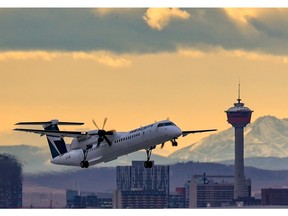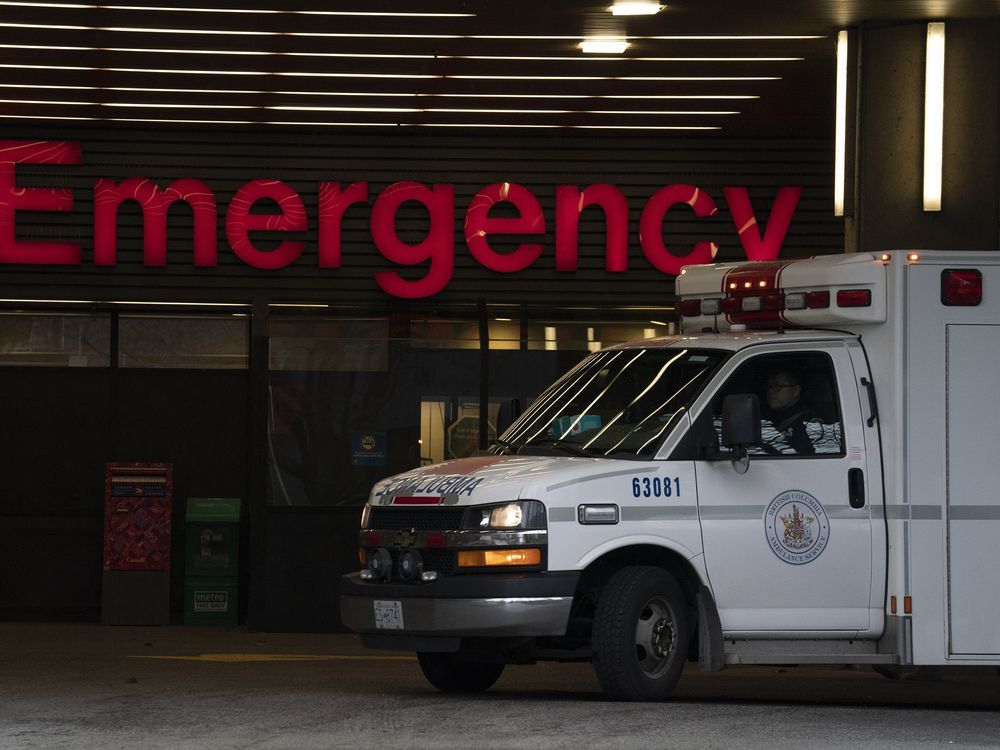On a flight to Kamloops from Vancouver last year passengers who weren’t strapped in tightly hit the ceiling. Some prayed, others screamed
Published Dec 30, 2024 • Last updated 6 minutes ago • 6 minute read

Brodie Lynn was flying home to Kamloops from Vancouver last year when the plane, a 70-seat Dash 8, dropped precipitously.
Article content
Article content
Passengers who weren’t strapped in tightly hit the ceiling, he said. Fearing the worst, some prayed, others screamed.
“It was like being in a washing machine and only got worse as we came within (one kilometre) of the runway,” Lynn, who was a Nav Canada employee at the time, wrote in an internal report about the April 9, 2023, incident.
Advertisement 2
THIS CONTENT IS RESERVED FOR SUBSCRIBERS
Enjoy the latest local, national and international news.
- Exclusive articles by Conrad Black, Barbara Kay and others. Plus, special edition NP Platformed and First Reading newsletters and virtual events.
- Unlimited online access to National Post and 15 news sites with one account.
- National Post ePaper, an electronic replica of the print edition to view on any device, share and comment on.
- Daily puzzles including the New York Times Crossword.
- Support local journalism.
SUBSCRIBE FOR MORE ARTICLES
Enjoy the latest local, national and international news.
- Exclusive articles by Conrad Black, Barbara Kay and others. Plus, special edition NP Platformed and First Reading newsletters and virtual events.
- Unlimited online access to National Post and 15 news sites with one account.
- National Post ePaper, an electronic replica of the print edition to view on any device, share and comment on.
- Daily puzzles including the New York Times Crossword.
- Support local journalism.
REGISTER / SIGN IN TO UNLOCK MORE ARTICLES
Create an account or sign in to continue with your reading experience.
- Access articles from across Canada with one account.
- Share your thoughts and join the conversation in the comments.
- Enjoy additional articles per month.
- Get email updates from your favourite authors.
THIS ARTICLE IS FREE TO READ REGISTER TO UNLOCK.
Create an account or sign in to continue with your reading experience.
- Access articles from across Canada with one account
- Share your thoughts and join the conversation in the comments
- Enjoy additional articles per month
- Get email updates from your favourite authors
Article content
“Suddenly the aircraft went full power and went what felt like 30 degrees nose up.”
Recommended from Editorial
-

What is in-flight turbulence, and how can travellers protect themselves?
-

How climate change is already contributing to bumpier North Atlantic flights
The pilot aborted the landing, announced he didn’t have enough fuel to attempt another one, and returned to Vancouver.
“After a very bumpy ride back to YVR we exited the aircraft; the air (hung) thick with the smell of urine and feces from people who thought it was the end,” Lynn said.
Lynn, an electronics technologist, concluded that low-level wind shear — a sudden change in wind direction or speed at low altitude — was at least partially to blame, and he questioned why Canadian airports don’t have the same instruments that are in use at some major U.S. airports that can detect the phenomenon and warn pilots about it in real time.
He’s not alone in sounding the alarm.
“There’s probably going to have to be an accident,” said John Gradek, who teaches aviation management at McGill University. “I don’t think we’re going to do anything prior to that.”
Advertisement 3
Article content
Just plug “wind shear landing” into YouTube and watch as multiple types of aircraft wobble and dip their way down to runways like children’s toys manipulated by an unseen hand.
“Wind shear can bring down an airplane,” said Capt. Doug Morris, a senior airline pilot and aviation meteorology professor at the Florida Institute of Technology who has authored four books on aviation.
He called on Canadian airports to introduce low-level wind shear alert systems.
“Basically, it tells you there’s wind shear at the airport,” Morris said. “You could still land. I could override it. But you better make sure you know what you’re doing.”
Canadian authorities are well aware of the risks. Low-level wind shear came under scrutiny after an Air France Airbus flying from Paris on Aug. 2, 2005, landed roughly in heavy weather at Toronto’s Pearson International Airport with 297 passengers and 12 crew members aboard.
“The aircraft touched down about 3,800 feet down the 9,000-foot runway; it was not able to stop on the runway and departed the far end at a groundspeed of about 80 knots,” said the Transportation Safety Board report from December of 2007.
By signing up you consent to receive the above newsletter from Postmedia Network Inc.
Article content
Advertisement 4
Article content
The aircraft stopped in a ravine “and caught fire,” said the TSB report. “All passengers and crew members were able to evacuate the aircraft before the fire reached the escape routes. A total of two crew members and 10 passengers were seriously injured during the crash and the ensuing evacuation.”
It recommended Transport Canada “establish clear standards limiting approaches and landings in convective weather for all air transport operators at Canadian airports.”
But a decade later, Transport Canada told the TSB that “there are no universal quantitative windshear avoidance criteria that provide unambiguous go/no-go decision guidelines, and that there is no assured detection and warning system in operation which can measure windshear intensity along a specific flight path.”

The TSB’s “recommendations on enhancing connective weather detection have largely fallen on deaf ears” at Transport Canada, where they cite a lack of international standards, said Gradek.
The resistance comes down to money, said Gradek: It would cost millions of dollars per airport to install low-level wind shear alerting systems.
Advertisement 5
Article content
Hicham Ayoun, who speaks for Transport Canada, said the ministry has raised the issue at the International Civil Aviation Organization as far back as 2010. “The result of these discussions was general agreement that any standard related to flight near convective weather in the terminal environment would require international collaboration given the potential operational impact of such a standard.”
In the meantime, keeping planes safe is up to the discretion of air traffic controllers and pilots, Ayoun said.
Air traffic controllers can “restrict the flow of air traffic into a particular airport due to weather conditions, but the ultimate decision to conduct an approach or landing rests with the pilot,” he said. “Transport Canada requires that pilots be familiar with the available weather information that applies to their intended flight, and that flight crews provide safety instructions to passengers before take-off, in-flight, during descent and at landing.”
Nav Canada “is monitoring technological development in this area for potential future applications in Canada,” said Maryam Amini, who speaks for the not-for-profit corporation that provides air navigation services for Canada.
Advertisement 6
Article content
“It is important to note that pilots are highly trained to safely manage wind shear situations, and many aircraft are equipped with onboard wind shear detection systems.”
But onboard systems only tell you when there’s wind shear in the immediate vicinity, said Morris.
“It will start yelling at us, ‘wind shear, wind shear,’ and then we have to take evasive action to get out of the wind shear situation. That’s what we practice in the simulator,” said Morris, who has been an airline pilot for nearly three decades.
Most major airports in the U.S. have low-level wind shear alert systems, he said, noting the technology was developed after a Delta Air Line flight crashed at Dallas-Fort Worth on Aug. 2, 1985, killing 137 people and injuring 25 others.
“Mountains can kick off low level wind shear. Thunderstorms kick off low level wind shear. And that’s what happened with Dallas-Fort Worth,” Morris said.
There’s probably going to have to be an accident,
In Canada, air traffic controllers rely on pilot reports to identify wind shear and pass that information on to other pilots, said Capt. Tim Perry, Canadian president of the Air Line Pilots Association.
Advertisement 7
Article content
“You’ll be flying into, say, Calgary and there will be reports of wind shear. Maybe you encounter it and maybe you don’t,” said Perry, a pilot with WestJet for the last 15 years.
“We’re always going to report and that’s always part of it. That’s part of the system in the U.S. as well. But we would love to see technology that supports what we already do.”
The technology is “not 100 per cent foolproof,” Gradek said. “You have false warnings, and sometimes it doesn’t detect wind shear totally.”
But pilots practice in simulators dealing with wind shear during take-offs and landings, he said.
“That is one of the key elements of recurrent training,” he said. “If you don’t pass it, you don’t get your licence renewed.”
Experienced pilots can use radar to predict wind shear, Gradek said. “You typically know the atmospheric conditions and the weather conditions around which wind shear would be prevalent, so you psychologically prepare for it. And then when the alarm goes, you’re on auto response. You know exactly what you have to do.”
Ground-based low-level wind shear alert systems “are added insurance,” he said.
Advertisement 8
Article content
“If the wind shear is beyond your capability as a pilot, or if it’s too extreme for the aircraft, you call the shot — you divert.”
That’s what the pilot at the controls of the Dash 8 carrying Lynn to Kamloops did.
After the Kamloops drama, Nav Can’s CEO Ray Bohn responded to Lynn’s concerns this past spring.
“These open conversations are exactly the kind of outreach we appreciate to help drive discussions on operational issues,” Bohn said in his April 4 response. “Your question on low-level wind shear detection is important, especially as we continue to assess the impacts of the changing climate.”
But in August, Lynn heard back that the issue he had raised about low-level wind shear did not fall within the scope of Nav Can’s safety reporting program.
Lynn, who had worked for Nav Can for nine years, invoked his right to refuse unsafe work, arguing his employer was “operating a counterfeit hazard reporting system.” But Employment and Social Development Canada deemed his complaint frivolous.
“I refused to come back so they fired me,” he said in a recent interview.
Our website is the place for the latest breaking news, exclusive scoops, longreads and provocative commentary. Please bookmark nationalpost.com and sign up for our daily newsletter, Posted, here.
Article content
.png)
 3 days ago
17
3 days ago
17




































 Bengali (BD) ·
Bengali (BD) ·  English (US) ·
English (US) ·